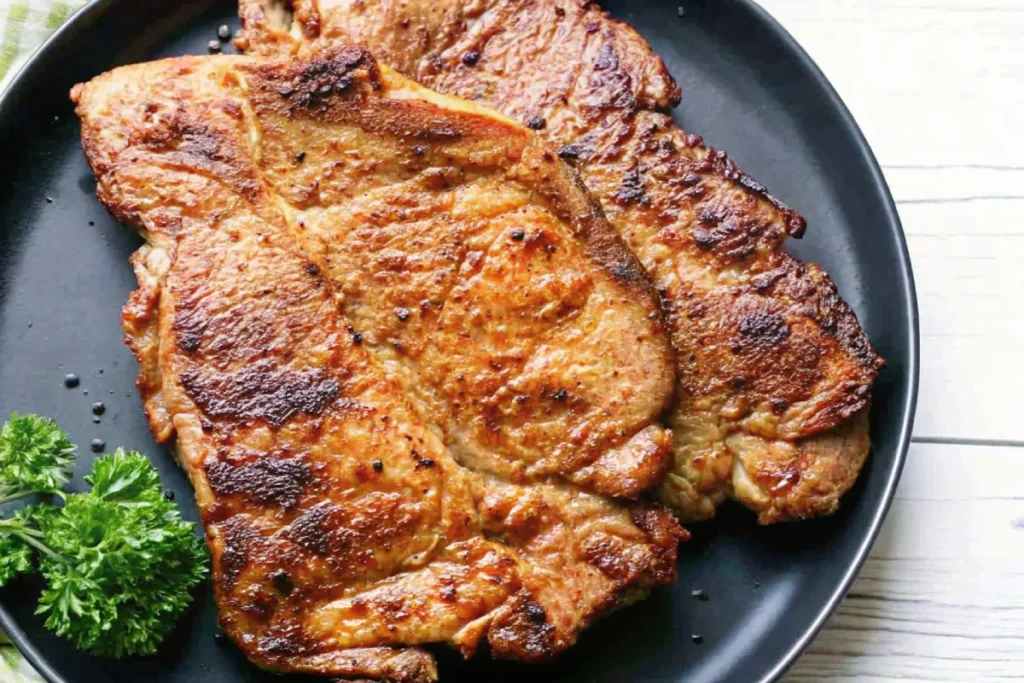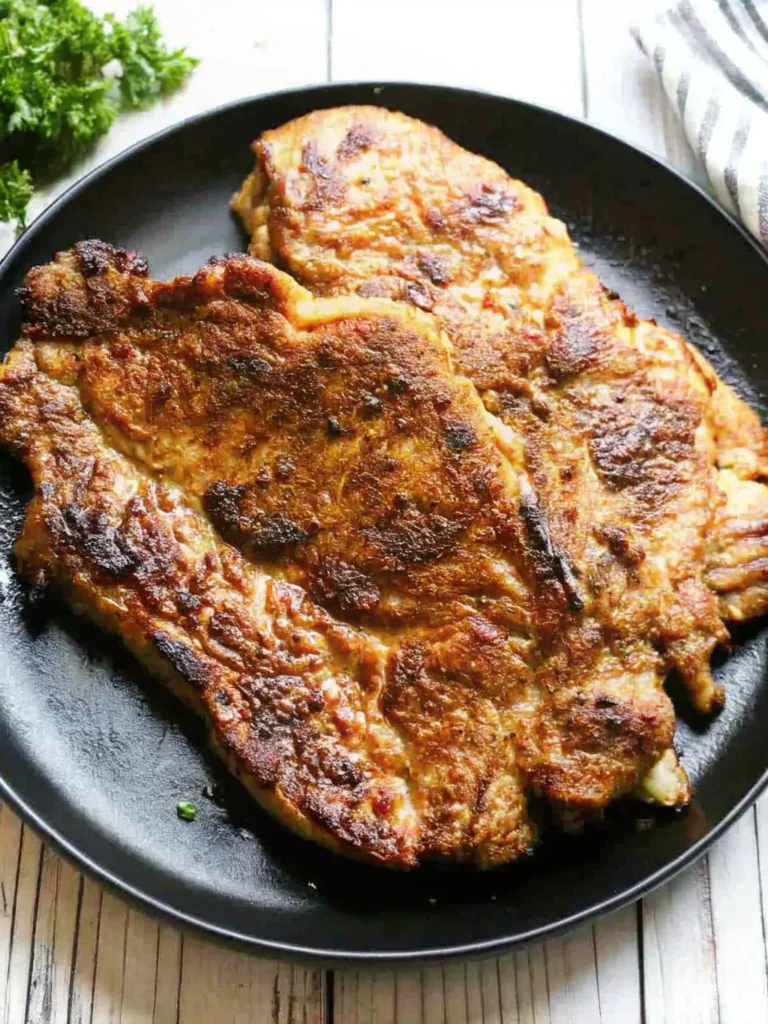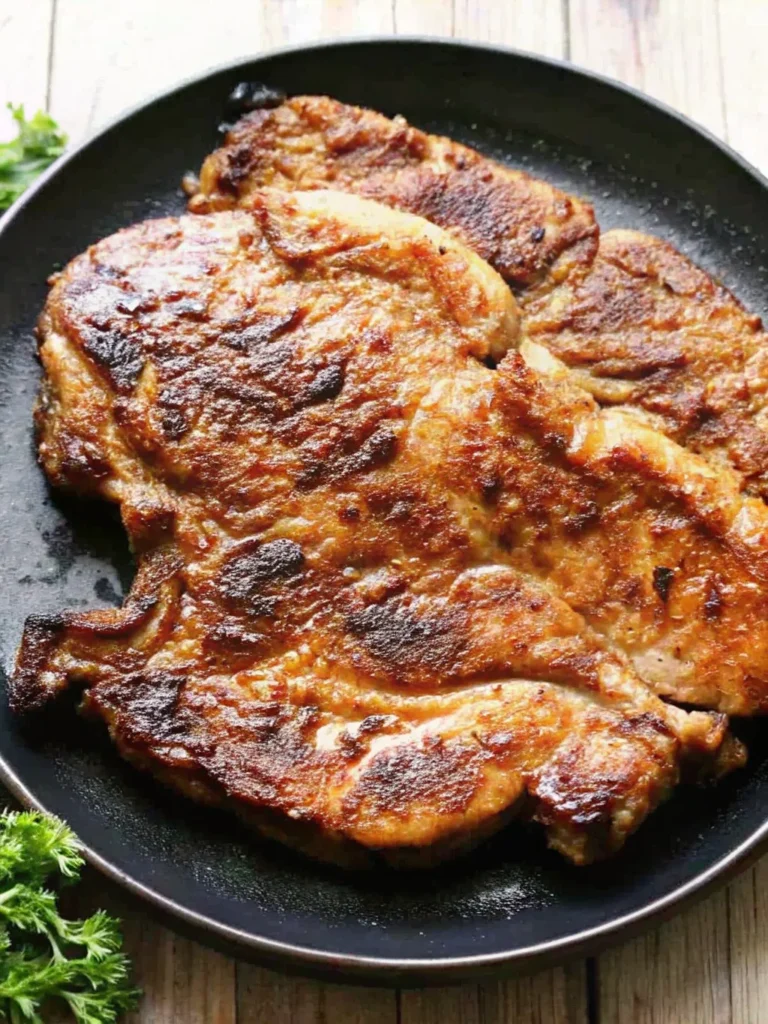What is a pork steak? It’s a flavorful cut of meat from the pork shoulder, packed with rich marbling and versatility. If you’ve ever wandered through the meat section or scanned a BBQ menu and spotted “pork steak,” you might’ve wondered what it actually is. Is it a pork chop? Is it a steak? And how is it different from the other cuts of pork we know and love? Well, buckle up because we’re about to break it all down—casual, straightforward, and full of flavor (just like pork steak itself).

The Basics: What is a pork steak?
Pork steak is a cut of meat that comes from the pork shoulder, also known as the Boston butt or blade steak. This is where things can get confusing because, despite the name, the Boston butt has nothing to do with the pig’s rear end. It’s actually from the shoulder area, which is known for its rich marbling and flavor-packed meat.
Think of pork steak as the juicier, more affordable cousin of the beef steak. It’s a slice of pork shoulder, cut into steaks that are usually around ½ to 1 inch thick. This cut is prized for its tenderness and bold, porky flavor when cooked properly.
How Is It Different From Other Pork Cuts?
Now, let’s clear up the confusion between pork steak, pork chops, and other pork cuts:
- Pork Steak vs. Pork Chop:
- Pork chops come from the loin, which is a leaner part of the pig. This makes chops more delicate and less fatty compared to pork steak.
- Pork steaks, on the other hand, are cut from the shoulder and have a higher fat content. This makes them way more flavorful and forgiving if you accidentally cook them a little longer.
- Pork Steak vs. Pork Shoulder Roast:
- The difference is all in the preparation. Pork shoulder roast is typically cooked as a whole roast, low and slow.
- Pork steak is simply a steak-sized slice of that same shoulder roast. It’s more versatile and quicker to cook.
- Pork Steak vs. Pork Ribs:
- While both cuts are great for grilling and BBQ, ribs have a bone structure that requires longer cooking times to break down the connective tissue. Pork steaks? They’re easier and quicker to whip up.

How Do You Cook Pork Steaks?
Here’s where things get fun. Pork steaks are a dream for any cook, whether you’re a grill master or a weeknight dinner warrior. Here are a few foolproof methods:
1. Grilling
- Why It Works: The fat in pork steaks melts beautifully on a hot grill, giving you smoky, crispy edges.
- Pro Tip: Marinate the steak for at least an hour in something sweet and tangy (like BBQ sauce or a mix of honey and soy sauce). Cook over medium heat, flipping occasionally, until you hit an internal temp of 145°F.
2. Pan-Frying
- Why It Works: Ideal for a quick and satisfying meal. On top of that, the pan drippings could easily be made into some wonderful gravy.
- Pro Tip: Season with salt, pepper, garlic powder, and a dash of paprika. Cook in a hot skillet with some butter or oil for 4–5 minutes per side.
3. Slow-Cooking
- Why It Works: Pork shoulder is rich in collagen and fat, making it ideal for slow cooking. This method results in meat that’s fall-apart tender.
- Pro Tip: Throw your pork steaks in a slow cooker with onions, garlic, and BBQ sauce. Cook on low for 6–8 hours, and you’ll have something magical by dinnertime.
4. Baking
- Why It Works: Baking lets you infuse the meat with extra flavors by cooking it in a sauce or marinade.
- Pro Tip: Lay pork steaks in a baking dish, cover them with your favorite BBQ sauce or gravy, and bake at 375°F for about 30–40 minutes.
If you’re looking for a step-by-step guide, check out this pork steak recipe to create a perfectly baked dish every time!
Why People Love Pork Steaks
And as far as things go, pork cuts are surely underrated. Very cheap and the easiest one to cook, full of rich flavors; the cut can be grilled in the summer and smoked or slow-cooked heated in winter – they fit perfectly with every season and style of cooking. And nowhere does the beauty of cooking end – that marbling allows juices and moisture to remain even when a novice tries it out. Also forgiving, so despite the cooking time disregarded, they’re still bound to taste like heaven.

Fun Fact About Pork Steaks
Did you know pork steaks are a Midwest staple? In states like Missouri (shoutout to St. Louis!), you’ll find pork steak grilled to perfection and slathered in sweet BBQ sauce. It’s a backyard BBQ favorite that locals swear by.
Pairing Pork Steaks with Sides
If you’re serving pork steak, you gotta have some killer sides to go with it. Here are a few crowd-pleasers:
- Mashed Potatoes: Because pork steak and gravy on top of creamy mashed potatoes? Pure comfort food.
- Grilled Veggies: Throw some zucchini, bell peppers, or corn on the grill while you’re cooking the steaks.
- Coleslaw: The tanginess of coleslaw perfectly balances the richness of pork steak.
- Mac and Cheese: It’s indulgent, cheesy, and exactly what you want on your plate.
- Baked Beans: The smoky, sweet flavor of baked beans complements BBQ pork steak beautifully.
The History of Pork Steaks
You might be surprised to learn that pork steaks have a bit of history attached to them—especially in the Midwest. The cut gained popularity in the St. Louis area in the 1950s, where butchers started slicing pork shoulder into steak-sized portions to meet the demands of budget-conscious families. This simple innovation turned pork steaks into a backyard barbecue icon, especially when paired with tangy, sticky BBQ sauce. To this day, St. Louis BBQ culture proudly celebrates pork steak as a staple, proving that delicious doesn’t have to be complicated or expensive.
Best Seasonings for Pork Steaks
If you’re wondering how to make your pork steak shine, the seasoning is key. While pork steak is naturally flavorful thanks to its marbling, adding the right spices can take it to the next level. A classic rub with salt, pepper, garlic powder, and smoked paprika is always a win, but you can also branch out:
- Cajun Seasoning: For a spicy, zesty kick that pairs perfectly with a cold beer.
- Herb Blend: Rosemary, thyme, and a hint of oregano give the meat an aromatic, earthy flavor.
- Sweet and Spicy Mix: Brown sugar, cayenne, and chili powder create that irresistible balance of sweet heat.
Whichever you choose, rub your seasoning in generously and let the pork steaks rest for 20–30 minutes before cooking. This helps the flavors absorb into the meat and creates a crust when seared or grilled.
Why Pork Steaks Are a Budget-Friendly Choice
One of the best things about pork steaks is their affordability. Because they come from the shoulder—a cut typically used for slow cooking—they’re much cheaper than leaner cuts like pork tenderloin or loin chops. That’s a big win for families looking to put a hearty, delicious meal on the table without breaking the bank. And here’s the kicker: Despite their lower price, pork steaks don’t skimp on flavor. Their rich marbling makes them taste luxurious, especially when cooked to perfection.
Can Pork Steaks Be Used in International Dishes?
Absolutely! Pork steaks are a versatile cut that works well in cuisines from all over the world. For example:
- Mexican: Use thinly sliced pork steak in tacos or marinate it in adobo sauce for a flavorful twist.
- Asian: Brush them with a hoisin glaze and grill them for a charred, sweet-savory vibe.
- Italian: Simmer pork steaks in marinara sauce and serve over pasta for a hearty, satisfying dish.
This variety of flavors that pork steaks can embrace is what makes them so well-loved by home cooks often dabbling in different flavors from around the world.
How to Tell If Pork Steaks Are Fresh
When buying pork steaks, freshness matters. Look for meat that has a bright pink color and a good amount of marbling (those white streaks of fat running through the meat). Avoid anything that looks dull, gray, or has an off smell. If you’re shopping for pre-packaged pork steaks, check the “sell-by” date and make sure the packaging is intact with no liquid pooling in the bottom. Fresh pork steaks not only taste better but also cook more evenly, giving you a top-notch result every time.
Pork Steak Nutrition Facts
Let’s talk numbers for a second. A typical 3-ounce serving of pork steak contains about:
- Protein: 22 grams
- Calories: 210
- Fat: 13 grams
However, this is what makes it very highly nutritious and full of flavor while having higher fat than lean cuts like pork loins and providing good sources of key nutrients, including zinc, iron, and B vitamins, all needed for energy and health. Just balance it with some veggies on the side, and you’ve got yourself a well-rounded meal.
Where to Buy Pork Steaks
If you’re not seeing pork steaks at your local grocery store, don’t worry—they’re easy to find with a little searching. Most supermarkets carry them in the fresh pork section, but you might find them labeled as blade steaks or pork shoulder steaks instead. For even fresher cuts, check out your local butcher shop and ask for pork steaks cut to your preferred thickness. And if all else fails, you can always buy a pork shoulder roast and slice it into steaks yourself. Pro tip: Look for bone-in cuts for maximum flavor!
FAQs About Pork Steak
Are Pork Steaks the Same as Pork Chops?
No, they’re different cuts. Pork chops come from the lean loin, while pork steaks are cut from the marbled shoulder. Pork steaks are richer, juicier, and more flavorful than chops.
What Cut Is a Pork Steak?
Pork steaks are slices of the pork shoulder, specifically the Boston butt. This cut is known for its marbling and fat, making it tender and packed with flavor.
Are Pork Steaks Any Good?
Yes! Pork steaks are juicy, flavorful, and versatile. Their marbling keeps them tender, making them perfect for grilling, frying, or slow cooking.
Why Is Pork Steak So Cheap?
Pork steak is inexpensive because it comes from the shoulder, a less premium cut. Despite the price, it’s incredibly flavorful and satisfying.
Wrapping It Up
While pork steak isn’t as renowned as pork chops or ribs, I assure you this is a complete sleeper hit. Grill, fry, or slow-cook; this cut’s always juicy, flavorsome, and just downright satisfying. Next time someone asks you, “What’s a pork steak?” you’ll have all the answers part issue recipe or two.
Affordable, very co-existent-of good measure-that can fill many bellies or pamper yourself with a home-cooked hearty meal. So if you have not yet tried pork steak, why are you stalling? Get out there and get some; you will thank me when it’s all over!

1 thought on “What Is a Pork Steak and Why Should You Try It?”